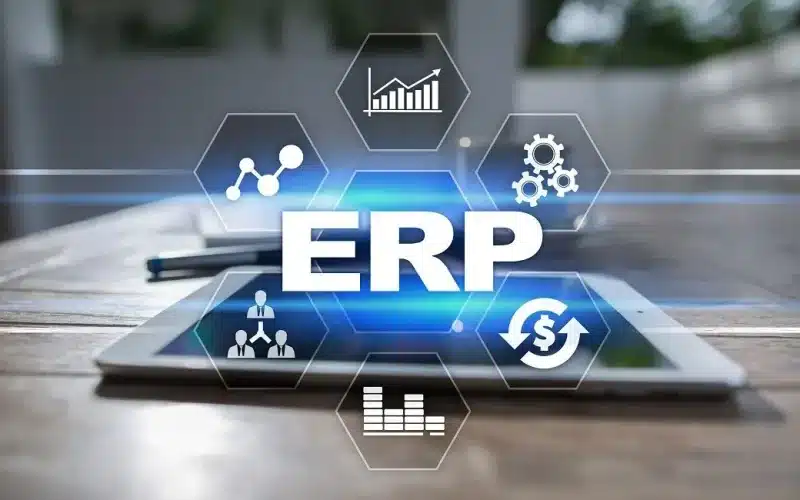A firm often consists of numerous different divisions, each of which handles a certain set of responsibilities. However, it is still the responsibility of the entire firm to remain together and exchange information about all the updates happening within the company. It’s important for all teams to be able to view information collected by others. Many business procedures are slowed down and inefficient since there isn’t a single unified system for the entire firm. Smart software solutions that can coordinate amongst departments are a must in order to avoid these types of embarrassing missteps. ERP, or enterprise resource planning, is an example of such a tool. Although most people in the business world are familiar with the word “ERP,” they might not understand the full function of an enterprise resource planning system for their companies. In this article, we will discuss workday enterprise resource planning.
What Is Enterprise Resource Planning?
Enterprise resource planning (ERP) is a software system used by firms to coordinate and control all of their core operations. Companies rely heavily on enterprise resource planning (ERP) software because it streamlines and automates so many administrative tasks.
Of course, here is where the necessity for granular permissions becomes apparent. Connecting the departments that interact directly with each other on a regular basis is crucial.
Thus, enterprise resource planning (ERP) is a software solution for managing the company’s data, optimizing and making that data accessible to all enterprise divisions. The efficiency gains in workflow that result from implementing ERP are substantial for your business. Thus, the following business procedures are enhanced by ERP:
- Asset management
- Payment gateways
- Employee info and updates
- Expense management
- Receipts
- Human resource management
- API Access
Enterprise resource planning (ERP) system has broad applicability. Some sectors, however, have an inflexible requirement for a single framework and consistent links across their many divisions and organizations. A few examples are:
- Agriculture and farming
- Manufacturing and distribution
- Education
- Nonprofit organizations
- Healthcare
- Professional services.
In addition, enterprise resource planning is adaptable and can be modified to fit the needs of a wide variety of businesses. When the necessary business operations are included, more tasks can be automated to save time and effort.
What Are the Components of ERP?
Each business management system provider offers their own unique set of options and extras. However, you shouldn’t jump the gun and focus on extras before choosing the core ERP features that your business requires. If you were shopping for a car, you wouldn’t walk into the showroom and immediately start talking about adding aftermarket rims without first considering fuel economy and safety. Similarly, ERP systems should be viewed in the same way. In the end, the ERP system is very customizable, allowing you to include only the tools and functions you need. Here are the components of the ERP.
#1. Human Resource
Human resource management must always come first. They are essential to the success of your business. Employee onboarding, offboarding, benefits management, and timekeeping should all be within the purview of your HR enterprise resource planning system.
Payroll processing software is a crucial HR element. The time and effort required to manually submit payroll and issue direct deposits are just not feasible. Instead, payroll processing—including withholding for taxes and benefits—is handled automatically by an HR module. If you have hourly employees, you can save yourself the trouble of manually entering their timesheets by using a timekeeping feature that is built right in.
#2. Customer Relationship Management
The survival and expansion of your business depend on your ability to effectively manage your clients and potential new ones. A customer relationship management (CRM) ERP system lets you store and manage all of your customer and lead information in one centralized location. Gaining insights from a CRM helps improve marketing and sales operations.
A customer relationship management system’s primary function is to store and organize information about your customers’ past purchases. By using this information, you can upsell or cross-sell similar goods to your customers, or target those who are less likely to make a purchase at a time when you think you can increase your revenue.
Furthermore, you can also utilize a CRM to keep tabs on who spoke with a lead, when, and what topics were covered. By using this information, you can better guide customers through the sales funnel by sending them targeted marketing materials and preventing sales representatives from making unnecessary follow-up calls.
#3. Business Intelligence
The concept of “business intelligence” (BI) is very recent. At least, that’s the case with respect to generic enterprise resource planning features. However, given the growing trend toward data-driven decision-making among firms, this feature has rapidly become a staple of enterprise resource planning (ERP) systems. The ERP software’s business intelligence component does the heavy lifting of data collection and analysis so you may make informed decisions about your company’s operations.
Furthermore, the top business intelligence (BI) ERP parts provide these insights through reports. The most crucial part of a business intelligence tool is its ability to generate meaningful reports based on the data it has studied. Numbers in various tables are the format of several reports. The most useful reports, however, are graphic representations that reveal patterns at a glance. If the BI tools you’re using have reporting capabilities, test them to see if they provide data visualization. Insights will be much more cryptic if this is not the case.
#4. Inventory Management System
One of the most interoperable enterprise resource planning components is the inventory management section. Inventory management is an integral part of supply chain management (SCM), but it also has a hand in other areas like sales and storage. Warehouse management and order processing are the primary functions of these parts.
The most effective parts of inventory management systems include monitoring functions that make human stock-checking unnecessary. Features such as various units of measure per product ID or SKU and revision level monitoring are also included.
#5. Supply Chain Management
Even with the aid of software, developing a functional supply chain is no simple task. For this reason, the supply chain management (SCM) part of an enterprise resource planning (ERP) system is among the most important. In order to optimize your supply chain, you need the greatest SCM functions, and that means gathering data in real-time.
Monitoring your supply chain in real-time allows you to identify and address problems as they arise, rather than waiting for data to arrive a day or more later. It also enables analytics with a predictive component. When coupled with real-time data, the SCM module can aid in demand planning, allowing for the creation of a production schedule that not only keeps up with but also slightly exceeds, actual demand.
#6. Financial Management
The final enterprise resource planning component concerns itself with information from the other sections. The financial management component integrates with the rest of your ERP system to facilitate the flow of money across your firm, from employee compensation to product distribution.
All of your financial information, including invoices, payments received, expenses incurred, budgets, and projections, are stored and analyzed in this section. It allows you to see patterns in your expenditure and identify periods of excessive spending or big profits. To optimize profits while minimizing expenses, you can utilize this information to adjust the procedures that are creating low earnings or high spending.
What Are the 3 Common Types of ERP?
Depending on the nature of your business and the features you need, many ERP packages offer a variety of integration methods across a wide range of industries. There are mostly three of them:
#1. Cloud-Based Integration
It is widely agreed that cloud-based integration is the most common method of deploying ERP solutions. Here’s how it goes down. Businesses can select the ERP vendors who will take care of their systems for a given time frame. That saves money since it means businesses can forego hiring some IT support staff. You must pick a trustworthy partner because they will have complete access to your company’s data. This integration method is the most cost-effective and is well-suited to the needs of smaller businesses with fewer personnel.
#2. On-Premise Integration
Integration with an on-premises enterprise resource planning (ERP) system is the antithesis of cloud ERP. In-house data centers host ERP solutions, and the services of IT professionals are required to keep them running smoothly. When you purchase a license for the enterprise resource planning (ERP) software, it is solely installed internally, giving you complete control over the system. Also, make sure your ERP is always up-to-date with the latest tools and systems available. This level of integration works best for large corporations, as it allows for complete oversight of all operations.
#3. Hybrid Software
The other two types of integration, cloud-based and on-premise, both feature the hybrid type. Only very specific markets and major corporations will find this useful. This kind of stores information in both on-premises and remote storage. It is typically employed by companies that began as relatively modest operations but are experiencing rapid expansion. Therefore, extra storage space is required for archival purposes. You probably already know that the requirements and needs of your business, as well as its size and rate of growth, are the only factors that will determine the best method of implementation for your firm.
Numerous deployment models are made possible by ERP systems. Option bundles, sometimes called “hybrid” deployment, may provide both hosting and deployment options. Incorporating benefits that were previously unavailable inside the current ERP deployment, these hybrid models can provide consumers with a versatile ERP system.
How Does ERP Work?
ERP systems, whether cloud-based, in-house, or a combination of the two, are designed to foster a mindset conducive to the real-time management of organizational processes. So, ERP systems work toward reducing costs that involve money, time, and effort.
Data from all parts of the company is obtained by enterprise resource management software, where they can be processed, stored in the cloud, and managed. In contrast to enterprise resource planning (ERP) system, manual data collection, processing, and standardization takes more time, which slows down the decision-making process.
The Enterprise Resource Planning (ERP) system enables seamless, cross-departmental, real-time data access for all stakeholders, from upper management down to individual workers. Information no longer needs to be gathered from multiple sources, saving both time and effort in the communication process.
Manufacturing, inventory and order management, customer service, sales, marketing, finance, etc. all benefit from sharing information to improve efficiency and accuracy in decision-making. In addition, ERP programs remove all opportunities for mistakes to occur. Further, an ERP system can tailor its data visualizations (such as charts, and graphs) to the specific requirements of the business.
Accounting and sales, for example, might use data collected by enterprise resource planning systems to compile the metrics necessary for making informed business decisions. The accounting team, for instance, has access to numerous spreadsheets containing relevant information. Using the same portal or enterprise resource planning system, a salesperson can keep track of closed deals at the same time.
Enterprise Resource Planning Example
Let’s take a look at a real-life example of enterprise resource planning.
#1. Fulton & Roark
Enterprise resource planning was effectively applied by Fulton & Roark, a manufacturer of men’s grooming products, to improve the tracking of inventory and financial data. The North Carolina firm, like many others, recorded its financial and inventory data using spreadsheets and accounting software, respectively.
As the business expanded, its procedures couldn’t keep up. The accounting software they were using was unable to record the metrics required for critical financial statements, and their inventory tracking system was too archaic to account for rising expenses. These failures necessitated the use of manual procedures, which in turn ate into valuable time and materials.
The Oracle NetSuite ERP solution was selected to help streamline operations and consolidate teams. Immediately, Fulton & Rourk was in a better position to detect inventory-related accounting problems, avoid the expense of having an outside party review their books, and more accurately reflect their financial standing.
#2. Cadbury
Cadbury, a worldwide confectioner and producer of the ubiquitous Cadbury egg, also boasts a fruitful ERP rollout. The company’s rapid expansion left it with inefficient warehouse management systems and thousands of unused systems.
Also, through the elimination of silos and the implementation of a uniform set of procedures and a new warehouse management system, the company was able to better coordinate the thousands of apps it uses.
What Is the Role of Enterprise Resource Planning?
Enterprise resource planning (ERP) systems are crucial for the management of tens of thousands of enterprises of varying sizes and across a wide range of industries. Some of the most prominent roles between ERPs are as follows:
- Data Analysis: A uniform set of operations is achieved through the use of an ERP system to hold data from diverse divisions within a business. This allows for instantaneous communication and analysis of data across all departments, leading to more informed decisions.
- Sales and Marketing: Enterprise resource planning systems can also help marketing and sales departments by streamlining tasks like lead generation, quote and order creation, commission management, and inventory tracking.
- Manufacturing: The day-to-day operations of a manufacturer are greatly simplified with the assistance of ERP systems. These include product planning; raw material procurement; production monitoring; forecasting; work order administration; shop-floor control; distribution planning and product tracking.
- Accounting: Accounting departments may better manage processes like accounts payable and receivable, costs, budgets, and projections with the help of ERP systems.
- E-commerce: When dealing with supply chain bottlenecks, logistics problems, or late deliveries, an e-commerce site can benefit greatly from the ERP system’s product creation, shipping, and supply chain modules.
Enterprise Resource Planning Function
Here are the top 5 enterprise resource planning functions.
#1. Finance
The enterprise resource planning finance and accounting function is crucial since it provides insight into a company’s financial standing and projections. Accounts payable (AP) and accounts receivable (AR) management, as well as general ledger maintenance, are essential components of this module. Documents including balance sheets, payment receipts, and tax statements are generated and stored as well.
In order to help the accounting department close the books on time and adhere to current revenue recognition rules, the financial management module can automate operations like billing, vendor payments, cash management, and account reconciliation. It also contains the information used by financial planning and analysis staff to generate scenario plans and generate P&L statements and board reports.
#2. Procurement
The procurement function facilitates the acquisition of resources necessary for the production and/or sale of a company’s output. This module aids in supplier relationship management by allowing businesses to maintain a list of approved vendors and associates those vendors with certain products. The module has the capability to automate quotation requests, as well as monitor and evaluate incoming quotes.
The procurement component aids the purchasing department in creating and sending out purchase orders when a quote has been accepted. Following the purchase order’s transformation into a sales order and shipment, stock levels can be automatically adjusted.
#3. Order Management
From order inception through shipment, an order management system keeps tabs on things. This enterprise resource planning function receives orders from customers, sends them to the appropriate warehouse, distribution center, or retail store, and keeps tabs on their progress as they are processed, packed, and sent. Furthermore, the order management component ensures that orders are never lost and increases the percentage of items delivered on time, which in turn keeps customers satisfied and reduces the need for expensive expedited shipping.
In-store fulfillment, warehouse fulfillment, or a third-party fulfillment partner may all be viable options, depending on inventory levels and the location of the customer placing the order. In addition, this is where more complex order management software comes in handy.
#4. Workforce Management
For businesses that rely more on hourly workers than paid ones, a workforce management component can be useful. It’s a useful tool for tracking employee time and attendance as well as other metrics like productivity and absenteeism.
Also, payment is another function that may be part of the workforce management section. Automatic paychecks and tax withholdings, as well as employee cost reimbursement, are processed by the payroll module. It can also provide reports on payroll costs, overtime hours worked, and other related key performance indicators.
#5. Marketing Automation
Some e-commerce platforms also include a marketing automation tool. A marketing component coordinates promotional efforts across multiple online and mobile platforms. It provides extensive customer segmentation features, allowing you to send precise emails to specific groups of people depending on campaign rules.
Whether integrated into an enterprise resource planning (ERP) system or used as a stand-alone solution, marketing automation software may generate insightful insights on the efficacy of campaigns, informing both strategy and budgeting moving forward. Leads, client loyalty, and ultimately, sales, are all boosted by these applications.
Workday Enterprise Resource Planning
Workday ERP is an all-in-one online platform for enterprise resource planning (ERP), human capital management (HCM), enterprise resource planning (ERP), professional services automation (PSA), project management (PM), analytics (BI), and more. Enterprise resource planning, or ERP, is software used to manage resources and transform data throughout an organization. In addition, large and medium-sized businesses make up the bulk of Workday’s clientele.
Workday enterprise resource planning system products include:
- Analytics and Reporting
- Enterprise planning
- Payroll and workforce management
- Platform and Product Extensions (PPE)
- Talent management
- Financial management
Business-wide financial, personnel, and sales planning, in addition to real-time analytics, are all part of Workday Enterprise Resource Planning. Accounting and reporting are both services provided by Workday Financial Management. Human capital management and employee experience are both available in Workday HCM. Project, expense, and time tracking, as well as billing, are all features of Workday’s PSA.
Which Types of Businesses Use Workday Enterprise Resource Planning?
Businesses in these industries use Workday enterprise resource planning:
- Higher education
- Insurance
- Retail
- Hospitality
- Energy and resources
- Media and entertainment.
- Technology
- Communications
- Manufacturing
- Healthcare and Life Sciences
In addition, non-profit and government organizations also use the workday enterprise resource planning system.
How Much Does Workday Cost?
Workday enterprise resource planning pricing incorporates the cost of Workday and third-party add-ons, launch packages, Workday training courses, and Workday partners consulting services into a single per-user SaaS subscription. Additional internal IT and other employee costs incurred during deployment are also factored in. Also, read WORKDAY SOFTWARE: Meaning, Uses, Training & Reviews.
What Are the Benefits of ERP?
Enterprise resource planning (ERP) is used by businesses for a number of reasons, including growth, cost reduction, and enhanced functionality. While each company is likely to have slightly different results, there are certain commonalities worth noting.
#1. Boosts Efficiency
Without the need for support from an expert IT employee, users of ERP systems and cloud services can gain valuable insights from comprehensive reports. Also, on the go (or from afar), disperse workers can use an enterprise resource planning system to spot issues, swiftly gather data from many sources, and implement effective fixes.
#2. Improves Teamwork
Departments have a greater capacity to work together and share information; a synergized workforce can boost productivity and morale by making it clear to workers how their job supports the company’s overarching goals. In addition, time previously spent on routine, manual chores is freed up so that workers can focus on more significant projects.
#3. Provides an Edge Over Rival Brands
Businesses that implement competent, intelligent, and tailored ERP solutions can see a dramatic improvement in their standing. In order to handle consumer problems and increase engagement, businesses need access to data in real-time, accurate information, and timely information about potential prospects.
#4. Improves Data Safety
Insights into the inner workings of a company’s operations, procedures, and technologies are vital to its success. As a result, having a central data store either on-site or in the cloud can reduce the vulnerabilities and inaccuracies stemming from data silos, such as when creating reports, bills, etc.
What Is the Difference Between SAP and ERP?
ERP, or Enterprise Resource Planning, is a suite of programs used to manage company processes in a single system. Whereas, SAP is an international software conglomerate that offers several enterprise resource planning (ERP) applications. The enterprise resource planning system (ERP) is a tool used in many different sectors to manage their company activities.
Conclusion
ERP, or enterprise resource planning, is software that unifies and streamlines numerous corporate operations. Better visibility allows businesses to better plan and deploy their resources. However, without ERP, organizations have a tendency to function in silos, with different divisions using different, incompatible systems.
ERP systems encourage collaboration and information sharing across departments and teams, as well as the integration of systems for greater productivity and efficiency. Moving to an ERP system, however, can backfire if the company doesn’t take the time to ensure that its culture is ready for change and that its organizational structure can accommodate the new system.
Enterprise Resource Planning FAQs
Is Excel an ERP system?
No. Excel is not an ERP system. ERPs are less prone to human mistakes since they constitute a single unit. Excel, on the other hand, is a very hands-on program. Instead of having a centralized and connected system like an ERP, your firm will rely on numerous Excel spreadsheets that all contain the same information.
What are the main objectives of ERP?
In addition to these primary objectives, ERP aims to provide a software roadmap of the functional activities of a firm, boost accuracy in outcomes, expand operational flexibility, and boost productivity.
Similar Articles
- How to Calculate Overtime: Free Tips, Guide & What You Should Know
- 5 Reasons Why ERP Software Is Important for Growth
- ERP INTEGRATION: Meaning, Strategy, Software & System
- RESOURCE PLANNING: Definition, Example, Types, enterprise & System
- APPLICATION INTEGRATION: Definition, software, enterprise & difference






